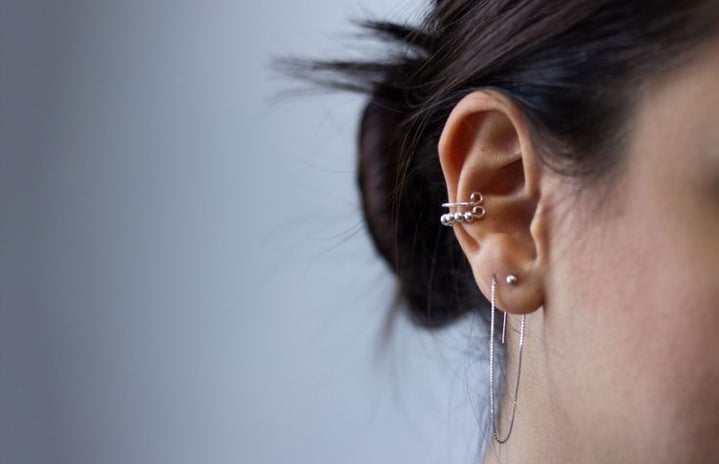When trying to accessorize an outfit, I always think that with the right necklace, the right rings and the right bracelets, my simple look can reach a whole new level of sophistication and sparkle. However, when accessorized with the right earrings, these subtle details can only then complete my look. With a balanced look of both metals, gems and diamonds (real and not real), these accessories add a unique twinkle that accentuates my favorite elements of edge and flavor, which makes my passion for fashion so much more enjoyable. Seeing how each individual’s style and personalities differ, here are seven cute piercings that any collegiette should explore if they are itching for their next piercing!
Disclaimer: If any of these piercings appeal to you, make sure to consult and seek out a professional piercer and research the necessary care required! Certain ear types may not be conducive to every piercing so it is extremely important to talk to a professional.
Related Article: Piercings 101: What To Know Before You Go Under The (Piercing) Needle
1. Helix
Although there are many different versions of the helix piercing, the standard helix piercing involves the upper cartilage portion of the ear. This piercing is often seen with either a hoop or a stud and it is a great introduction into the world of piercings. The helix piercing also can be done in pairs or triplets as well, which would be referred to as a double or triple helix. Although pain is subjective based on the individual, this area is typically not the most painful area.
2. Rook
Still focused on the upper cartilage portion of the ear, the rook piercing goes through the upper ridge of the ear and is positioned beneath the rim of the ear and above the tragus. This piercing is done with a curved barbell and similar to the helix, the rook is typically not the most painful piercing. The daith piercing is positioned just below the rook so if this piercing suits you, make sure to understand the differences in position between the two.
3. Snug
Moving down the ear, the snug piercing falls in between the anti-tragus, which is the triangle portion of cartilage by the lobe, and the inner rim of cartilage. This piercing also uses a curved barbell, similar to the rook, and lies horizontally in contrast to the rook’s vertical position. As a result, both the entrance and exit points of the snug appear and are visible in the front of the ear. However, snugs are sometimes considered to be one of the more painful cartilage piercings but it is still important to remember that the pain tolerance of each individual varies greatly.
4. Conch
The conch piercing is located in the middle cartilage portion of the ear and it resembles the helix in that there is more than one option on where it can be placed. The inner conch piercing is typically placed higher than the outer conch piercing depending on the folds of the individual ear. Inner conchs are typically more favorable towards a stud while outer conchs can sport a larger hoop. The pain for this piercing also falls in the typical range for most cartilage piercings.
5. Tragus
Working away from the center, the tragus piercing is located on the flap of cartilage in front of the ear canal. This location is optimal for a flashy stud that provides an extra glimmer of sparkle or color. Since this piercing again involves cartilage, the pain and healing process are similar to the above piercings; however, it is important to be aware that tragus piercings typically require a little more of a regimented cleaning approach given its location close to the ear canal.
6. Flat
Moving back towards the upper rim of the ear, the flat piercing is located just beneath this in the wide space of cartilage next to the rook piercing. This open area allows for flexibility in the piercing’s position, as well as the room for multiple piercings. Since the cartilage in this area is generally thinner, this piercing tends to lean on the more sensitive or painful sides in terms of cartilage piercings.
7. Industrial
The last piercing on this list is the industrial piercing, which is actually comprised of two piercings connected by an industrial barbell. One of the piercings is typically located through the upper rim of the ear near the helix, as well as through the anti-helix which is located on the opposite side above the tragus. Due to the two piercings being administered at one time, this area tends to be more tender in terms of pain; however, the aftercare is similar to that of other cartilage piercings.
Related Article: Most Popular and Most Uncommon Piercings
After reading about these piercings, this guide should help provide some more information, as well as provide a few additional piercings, that hopefully give a clearer representation of the latest piercing and fashion trends!



